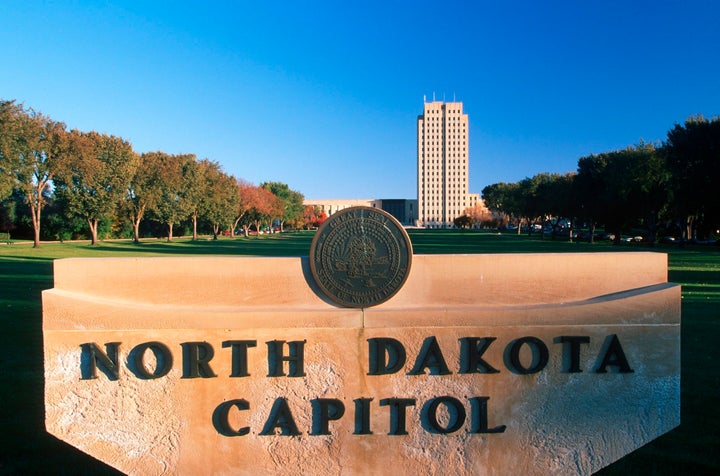
This article was originally published on 24/7 Wall St.
The combined sum of all income received by all Americans was $12.2 trillion in 2010. It was the end of what many economists consider the worst decade for the American economy since the 1930s. During the Great Recession GDP growth slowed to a crawl, and unemployment fell to levels not seen in decades. Starting in 2010 the nation began its long process of recovery. In 2015, personal income amounted to $14.0 trillion, a 14.6% increase from five years earlier.
While all states have enjoyed some economic recovery, growth was far from even. North Dakota led the nation with a 27.9% increase in personal income, while Maine’s 4.2% personal income growth was the slowest. To identify the states where income is booming, and the states where it is not, 24/7 Wall St. reviewed personal income data from the Bureau of Economic Analysis for each state over the five years through 2015.
Personal income is the sum of the net earnings of all people from all sources before taxes, the largest component of which is wages and salaries. Most of the states where personal incomes grew the fastest have strong, flourishing industries that helped weather the recession and continue to aid the recovery. In an interview with 24/7 Wall St., Chad Shearer, senior research analyst at the Brookings Institution’s Metropolitan Policy Program, said, “The biggest factor in explaining why some places have recovered faster than others is really their industrial composition.”
Click here to see the states where income is booming (or not).
The U.S. mining sector grew by 36.8% from 2010 through 2014, the most of any industry. While mining accounts for only 2.6% of the national economy, incomes in states with large mining sectors grew the fastest. In North Dakota, where mining accounts for the largest share of state GDP, personal income grew by 27.9% — the fastest in the country.
On the other hand, the government sector experienced the second slowest growth after the utilities sector. In 2013, an automatic federal budget sequestration took place, initiating a chain of state budget cuts as well. “States were not getting the aid that they normally would have, and also saw their tax revenues diminish very quickly. So during the recession, we saw huge, huge spending cuts,” Shearer said. In New Mexico, home to multiple military bases and federal laboratories, government operations accounted for 23.7% of GDP in 2014, the largest share of any state’s government sector. Overreliance on a sector vulnerable to spending cuts partially explains why new Mexico had the sixth slowest five-year personal income growth.
Economic growth is closely related to income growth, and the two almost always move in tandem. In many cases, however, an expanding population can offset sluggish GDP growth. In many Sun Belt states such as Florida, South Carolina, and North Carolina, GDP growth from key industries such as manufacturing and real estate underperformed and were outpaced by most other states. However, these are the states with the largest inbound migration. The additional salaries from new workers and pension incomes from retirees boosted these states’ personal incomes. In states such as Colorado and Texas, both rapid population and GDP growth helped yield some of the fastest growing personal incomes in the country.
Personal income, or the sum of net earnings by all people from all sources, was reviewed in each state and in each year from 2010 to 2015 from the BEA. Income growth rates were calculated from real personal income in 2010 to real personal income in 2015, all in 2009 dollars. The BEA has not yet published real personal income figures for 2014 or 2015. We derived our own estimates of real personal income by adjusting nominal figures from regional and national prices, based on the BEA’s methodology. Due to limited data availability, real personal income estimates for 2014 and 2015 were calculated with 2013 regional prices. Also from the BEA, we considered industry contributions to GDP for 2010 and 2014. Labor force and unemployment came from the Bureau of Labor Statistics. Socioeconomic factors, such as educational attainment rates, poverty rates, and net population change from migration, came from the U.S. Census Bureau’s 2015 American Community Survey (ACS).
These are the states where incomes are increasing the most.
10. Oregon

> Personal income growth (2010-2015): 16.5%
> Per capita personal income 2015: $39,848 (11th lowest)
> Unemployment rate: 5.7% (15th highest)
> Pct. change in labor force (2010-2015): -0.7% (15th lowest)
Personal income went up in Oregon by 16.5% between 2010 and 2015, outpacing national income growth. Despite the overall positive trend, several negative measures suggest that incomes in the state are only rising for a select few. Like in many other states, despite the rise in personal income, the poverty rate also increased in the last five years, from 15.8% to 16.6%. Furthermore, while the vast majority of states with rapidly rising incomes had an influx of working-age residents, Oregon was a notable exception. The state’s labor force declined by 0.7% over the five years since 2010.
9. Alaska

> Personal income growth (2010-2015): 17.3%
> Per capita personal income 2015: $48,299 (6th highest)
> Unemployment rate: 6.5% (4th highest)
> Pct. change in labor force (2010-2015): 0.5% (20th lowest)
Personal income in Alaska grew faster than it did nationally even as income earners left the state. Alaska is the only state that lost more residents than it gained through migration between 2010 and 2015 and still managed to have above-average income growth. Although the state’s unemployment rate dropped over that period, 6.5% of the workforce is still unemployed, the fourth highest jobless rate of all states. Mining contributed to five-year income growths in a number of other states. While Alaska’s mining industry accounts for 26.5% of the state’s economy — the second highest such share of all state mining industries — five years ago mining accounted for close to 30% of the economy.
8. Washington

> Personal income growth (2010-2015): 18.5%
> Per capita personal income 2015: $45,358 (18th highest)
> Unemployment rate: 5.7% (15th highest)
> Pct. change in labor force (2010-2015): 0.9% (24th lowest)
Half a decade ago, the average resident in Washington earned $40,714, about $4,600 less than per capita income across the state in 2015. Economic expansion was primarily driven by growth across several key industries. The public sector, which accounts for 14.1% of the state’s GDP, expanded by 9.4% between 2010 and 2014, considerably faster than the 6.2% sector growth nationwide. Home to Microsoft’s headquarters, Washington’s information industry also more than doubled the pace of the industry’s growth nationwide.
7. Wyoming

> Personal income growth (2010-2015): 18.6%
> Per capita personal income 2015: $52,833 (3rd highest)
> Unemployment rate: 4.2% (15th lowest)
> Pct. change in labor force (2010-2015): 0.9% (23rd lowest)
According to the EIA, Wyoming’s natural resources provide more energy to other parts of the country than any other state. Some form of energy — coal, natural gas, crude oil — is produced in all but one of Wyoming’s 23 counties. Wyoming’s mining sector accounts for 34% of the state’s GDP, the highest such contribution compared to other state mining sectors. For residents employed in mining, incomes are no longer increasing at the rate they were, likely because of the recent energy sector downturn. Personal income in the state overall, however, remains high and continues to rise. This may be due to income earned through means other than wages — income from Wyoming property, for example, has risen substantially in recent years.
6. Oklahoma

> Personal income growth (2010-2015): 18.8%
> Per capita personal income 2015: $45,070 (20th highest)
> Unemployment rate: 4.2% (15th lowest)
> Pct. change in labor force (2010-2015): 4.2% (11th highest)
Only a handful states had a bigger income spike than Oklahoma over the last five years. In that time period, information was the only sector to put a drag on the state economy, and the expansion of a majority of sectors in the state outpaced the corresponding national growth. Rising incomes are likely partially attributable to an expanding population. Oklahoma’s labor force increased 4.2% between 2010 and 2015, considerably faster than the corresponding 1.3% national growth.
5. Colorado

> Personal income growth (2010-2015): 19.9%
> Per capita personal income 2015: $45,142 (19th highest)
> Unemployment rate: 3.9% (10th lowest)
> Pct. change in labor force (2010-2015): 3.8% (12th highest)
Personal Income in Colorado increased by nearly 20% between 2010 and 2015, one of the sharpest such increases in the country. Every major economic sector in the state expanded over that time period, and two-thirds outpaced their national growth. Rapidly increasing incomes were also likely spurred by an increasing labor force and a decreasing unemployment rate. Between 2010 and 2015, Colorado’s labor force grew by 3.8% as unemployment decreased by 4.8 percentage points, each outpacing the corresponding national rates. Over that same time period, the state’s poverty rate dropped from 13.4% to 12.0%, one of the most drastic drops in the country.
4. Utah

> Personal income growth (2010-2015): 20.3%
> Per capita personal income 2015: $36,764 (the lowest)
> Unemployment rate: 3.5% (5th lowest)
> Pct. change in labor force (2010-2015): 8.0% (2nd highest)
While personal income in Utah grew by 20.3% between 2010 and 2015 — nearly the fastest growth of all states — Utah residents have some of the nation’s lowest incomes. Utah’s per capita income of $36,764 is the lowest in the nation. Still, the state’s poverty rate of 11.7% is among the lower rates nationwide, and the state’s jobless rate of 3.5% is nearly the lowest. Despite the low per capita personal income, the income growth and relatively strong economic factors are attracting people to the state. Utah’s labor force grew by 8% between 2010 and 2015, the second fastest such growth nationwide.
3. California

> Personal income growth (2010-2015): 22.7%
> Per capita personal income 2015: $42,909 (22nd lowest)
> Unemployment rate: 6.2% (7th highest)
> Pct. change in labor force (2010-2015): 3.5% (14th highest)
Personal income in California grew by 22.7% between 2010 and 2015, the third-fastest growth in the country. The contribution to GDP from California’s information sector — which includes many companies in Silicon Valley — increased by 18.4% between 2010 and 2014. This was the eighth largest such growth nationwide. Now, the sector accounts for 8.1% of the state’s economy, the second largest share of all states. California’s recent income growth has been even more robust, increasing by 6.0% last year, the largest increase in any state.
2. Texas

> Personal income growth (2010-2015): 23.5%
> Per capita personal income 2015: $44,241 (24th highest)
> Unemployment rate: 4.5% (18th lowest)
> Pct. change in labor force (2010-2015): 6.8% (4th highest)
Like in a number of other largely energy-dependent states, the dramatic five-year aggregate income growth in Texas has slowed in the past year. The state’s mining sector accounts for 13.5% of Texas GDP, the sixth largest share compared with other states. While the state’s mining sector grew 65.7% between 2010 and 2014 — the fifth largest growth from mining nationally — growth over the last year has been far less remarkable. In fact, Texas’ income grew by just 4.0% in 2015, in line with the overall national income growth.
Despite the mining sector’s tepid one-year growth, personal income in Texas was boosted in the fourth quarter of last year by bonuses paid to workers after the United Auto Workers successfully ratified new contracts.
1. North Dakota

> Personal income growth (2010-2015): 27.9%
> Per capita personal income 2015: $54,448 (2nd highest)
> Unemployment rate: 2.7% (the lowest)
> Pct. change in labor force (2010-2015): 9.5% (the highest)
The mining industry has been one of the primary drivers of income growth over the last five years. This was especially the case in North Dakota, where personal income grew by 27.9% over from 2010 to 2015, by far the largest income boom nationwide. Recently, however, the sector has waned significantly. Earnings in mining declined by 5.2% from 2014 to 2015 nationally, and the sector drove down income growth in North Dakota and in several other state economies that are highly dependent on the energy sector in the last year.